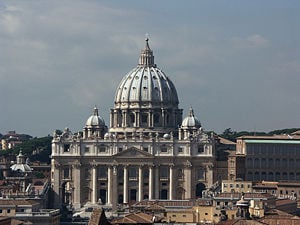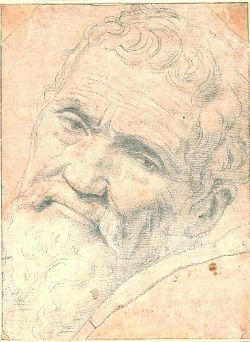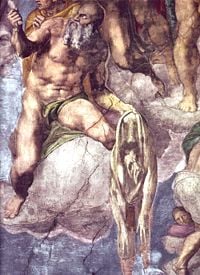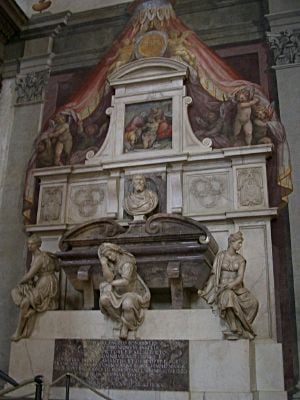| Michelangelo di Lodovico Buonarroti Simoni |
|---|
Chalk portrait of Michelangelo by Daniele da Volterra
|
| Born |
| March 6, 1475 near Arezzo, in Caprese, Tuscany |
| Died |
| February 18, 1564 |
Michelangelo di Lodovico Buonarroti Simoni (March 6, 1475 â February 18, 1564), commonly known as Michelangelo, was an Italian Renaissance sculptor, painter, architect, and poet. His versatility, accomplishment, and artistic mastery were so commanding that he is often considered the archetypal Renaissance Man, along with his rival and fellow Florentine, Leonardo da Vinci.
Michelangelo's output in every field during his long life was prodigious. When the sheer volume of correspondence, sketches, and reminiscences that survive is taken into account, he is the best-documented artist of the sixteenth century. Two of his best-known works, the Pietà and the David, were sculpted in his late twenties to early thirties. Despite his low opinion of painting, Michelangelo also created two of the most influential fresco paintings in the history of Western art: the scenes from Genesis on the ceiling of the Sistine Chapel at the Vatican in Rome and The Last Judgment on the chapel's altar wall. Later in life, he designed the dome of St. Peter's Basilica at the Vatican and revolutionized classical architecture with his invention of the giant order of pilasters.
In his lifetime, Michelangelo was often called Il Divino ("the divine one"), an appropriate sobriquet given his intense spirituality. His statue of David is testimony to the beauty of God's creation, even though the artist saw the raw material of inert stone as an obstacle to be mastered, a vault from which the sculptor laboriously released the work of art. One of the qualities most admired by his contemporaries was his terribilità , a sense of awe-inspiring grandeur. It was attempts by subsequent artists to imitate Michelangelo's impassioned and highly personal style that resulted in the next major movement in Western art after the High Renaissance, Mannerism.
Unique for a Renaissance artist, two biographies were published of Michelangelo during his lifetime. Biographer Giorgio Vasari called his work the pinnacle of all artistic achievement since the beginning of the Renaissance. This viewpoint was upheld in art history for centuries. Michelangelo died in 1564, the year of the birth of Galileo and William Shakespeare.
Early life
Michelangelo was born in 1475 near Arezzo, in Caprese, Tuscany. His father, Lodovico di Leonardo di Buonarotti di Simoni, was the resident magistrate in Caprese and podestà of Chiusi. His mother was Francesca di Neri del Miniato di Siena. Genealogies of the day indicated that the Buonarroti descended from Countess Matilda of Tuscany, so the family was considered minor nobility. Even so, the family was far from rich. Lodovico struggled financially and definitely hoped for the day when Michelangelo would contribute an income to help with the family obligations.
Michelangelo was raised in Florence. Later, during his mother's prolonged illness and following her death, he lived with a stonecutter and his wife and family in the town of Settignano where his father owned a marble quarry and a small farm. From a young age, he loved the feel of marble beneath his fingers and felt at home while working it. Michelangelo once said to Giorgio Vasari, the biographer of artists, "What little good I have within me came from the pure air of your native Arezzo and the chisels and hammers I sucked from my mother's milk."
Michelangelo devoted a period to grammar studies with the humanist Francesco d'Urbino. After a time, and in defiance of his father's wishes, Michelangelo chose to continue his apprenticeship in painting with Domenico Ghirlandaio, a well known painter, and in sculpture with Bertoldo di Giovanni. On June 28, 1488 he signed a contract for three years with Ghirlandaio. Lodovico tried to insist that his son take up a more practical and lucrative profession and was not averse to using harsh treatment and words to get his way. Michelangelo was driven from deep within. When Lodovico was unable to persuade or force him, amazingly, Lodovico was able to get Ghirlandaio to pay the young artist, which was unheard of at the time. In fact, most apprentices paid their masters for the education.
Impressed by Michelangelo's talent and work ethic, Ghirlandaio recommended him to the head of the ruling Medici family, Lorenzo de' Medici. After leaving Ghirlandaio in 1489, Michelangelo dedicated himself to his studies at Lorenzo's school from 1490 to 1492. There, he was influenced by many prominent people who modified and expanded his ideas on art, following the dominant Platonic view of the age. During this period, Michelangelo met literary personalities Pico della Mirandola, Angelo Poliziano, and Marsilio Ficino.
In this period Michelangelo finished Madonna of the Steps (1490â1492) and Battle of the Centaurs (1491â1492). 'Centaurs' was based on a theme suggested by Poliziano and was commissioned by Lorenzo de Medici. Michelangelo had become like a son to Lorenzo. After Lorenzo's death on April 8, 1492, Michelangelo quit the Medici court.
In the following months he produced a Wooden Crucifix (1493), as a thanksgiving gift to the prior of the church of Santa Maria del Santo Spirito who had permitted him some studies of anatomy on the corpses of the church's hospital. Between 1493 and 1494 he bought the marble for a larger than life statue of Hercules, which was sent to France and disappeared sometime in the 1700s.
He entered the Medici court again on January 20, 1494. Piero de Medici commissioned a snow statue from him. But that year, the Medici were expelled from Florence after the Savonarola rise. Michelangelo stayed in Florence for awhile, in a small room underneath San Lorenzo that can still be visited to this day. In this room, there are charcoal sketches still on the walls of various images that Michelangelo drew from memory. Michelangelo left Florence before the end of the political upheaval. He moved to Venice and then to Bologna.
In Bologna, he was commissioned to finish the carving of the last small figures of the tomb and shrine of St. Dominic.
After nearly a year away, he returned to Florence at the end of 1494. But he soon fled again to escape the turmoil and the menace of the French invasion. He was in his home city of Florence again between the end of 1495 and June of 1496. Michelangelo was touched by Friar Savonarola's preaching, moral severity, and his vision of renovation of the Roman Church.
A marble Cupid by Michelangelo was fraudulently sold to Cardinal Raffaele Riario as an ancient piece in 1496. The prelate found out that it was a fraud, but was so impressed by the quality of the sculpture that he invited the artist to Rome, where he arrived on June 26, 1496. On July 4, Michelangelo started to carve a larger than-life-size statue of the Roman wine god, Bacchus, commissioned by the banker Jacopo Galli for his garden.
Subsequently, in November of 1497, the French ambassador in the Holy See commissioned one of his most famous works, the Pietà . The contemporary opinion about this work â âa revelation of all the potentialities and force of the art of sculptureâ â was summarized by Vasari: âIt is certainly a miracle that a formless block of stone could ever have been reduced to a perfection that nature is scarcely able to create in the flesh.â
Though he devoted himself only to sculpture during his first stay in Rome, Michelangelo continued his daily practice of drawing. In Rome, Michelangelo lived near the church of Santa Maria di Loreto. Here, according to legend, he fell in love with Vittoria Colonna, marquise of Pescara and a poet.
The house Michelangelo lived in during this time was demolished in 1874. The remaining architectural elements saved by new proprietors were destroyed in 1930. Today a modern reconstruction of Michelangelo's house can be seen on Gianicolo hill.
Michelangelo returned to Florence from 1499â1501. Things were changing in the city after the fall of Savonarola and the rise of the gonfaloniere Pier Soderini. He was proposed by the consuls of the Guild of Wool to complete a project started 40 years before by Agostino di Duccio that had never materialized: a colossal statue portraying David as a symbol of Florentine freedom, to be placed in the Piazza della Signoria, in front of the Palazzo Vecchio. Michelangelo responded to the commissioning by completing his most famous work, David in 1504. This masterwork definitively established his fame as sculptor for his extraordinary technical skill and the strength of his symbolic imagination. The sculpture of David stands in the Academy in Florence. Indeed it is a stunning depiction of David, larger than life, so strong and handsome, as he contemplates his approaching confrontation with Goliath. The giant sculpture is so flawless that it is hard to imagine that it emerged from marble with the help of human hands.
Also during this period, Michelangelo painted the Holy Family and St. John, also known as the Doni Tondo or the Holy Family of the Tribune. It was commissioned for the marriage of Angelo Doni and Maddalena Strozzi. In the seventeenth century, the painting hung in the room known as the Tribune in the Uffizi. He also may have painted the Madonna and Child with John the Baptist, known as the Manchester Madonna and now in the National Gallery, London.
Under Pope Julius II in Rome: the Sistine Chapel ceiling
Michelangelo was invited back to Rome in 1503 by the newly appointed Pope Julius II and was commissioned to build the Pope's tomb. Under the patronage of Julius II, Michelangelo constantly had to stop work on the tomb to accomplish numerous other tasks. Due to interruptions, Michelangelo worked on the tomb for 40 years without finishing it. One interruption was the commission to paint the ceiling of the Sistine Chapel, which took four years to complete (1508 â 1512). According to Michelangelo's account, Bramante and Raphael convinced the Pope to commission Michelangelo in a medium not familiar to the artist, to divert him from his preference for sculpture into fresco painting, so that unfavorable comparisons with his rival Raphael would be made. However, this story is heavily discounted by modern historians and contemporary evidence, and may merely have reflected his suspicions, as he grappled with frustration over being separated from his beloved marble.
Michelangelo was employed by Pope Julius II to paint the 12 Apostles on the ceiling of the Sistine Chapel, but protested for a different scheme. Eventually he completed the work with over 300 Biblical figures in a composition. His figures showed the creation of Man, the creation of Woman, Adam and Eve in the Garden of Eden, and the drunkenness of Noah and the Great Flood. Around the windows he painted the ancestors of Christ. On the pendentives supporting the ceiling he alternated seven Prophets of Israel with five sibyls, female prophets of the classical world, with Jonah over the altar. On the highest section, Michelangelo painted nine episodes from the Book of Genesis. His drive to manifest what he imagined ruled him.
Under Medici Popes in Florence
In 1513 Pope Julius II died. His successor Pope Leo X, a Medici, commissioned Michelangelo to reconstruct the façade of the Basilica di San Lorenzo di Firenze in Florence and to adorn it with sculptures. Michelangelo agreed reluctantly. The three years he spent creating drawings and models for the façade, as well as attempting to open a new marble quarry at Pietrasanta for the project, were among the most frustrating in his career. Work was abruptly cancelled by his financially strapped patrons before any real progress had been made. The basilica lacks a façade to this day.
Apparently not the least embarrassed by this, the Medici later came back to Michelangelo with another grand proposal, for a family funerary chapel in the Basilica of San Lorenzo. Fortunately for posterity, this project, occupying the artist for much of the 1520s and 1530s, was more fully realized. Though still incomplete, it is the best example of the integration of the artist's sculptural and architectural vision. Michelangelo created both the major sculptures and the interior plan. Ironically, the most prominent tombs are those of two rather obscure Medici who died young, a son and grandson of Lorenzo. Lorenzo de' Medici, Il Magnifico is buried in an obscure corner of the chapel, without the free-standing monument that had been planned.
In 1527, the Florentine citizens, encouraged by the sack of Rome, threw out the Medici and restored the republic. A siege of the city ensued. Michelangelo went to the aid of his beloved Florence by working on the city's fortifications from 1528 to 1529. The city fell in 1530 and the Medici family rule was restored to power. Completely out of sympathy with the repressive reign of the ducal Medici, Michelangelo left Florence for good in the mid-1530s, leaving assistants to complete the Medici chapel. Years later his body was brought back from Rome for interment at the Basilica di Santa Croce, fulfilling the maestro's last request to be buried in his beloved Tuscany.

Last works in Rome
The fresco of The Last Judgment on the altar wall of the Sistine Chapel was commissioned by Pope Paul III. Michelangelo labored on the project from 1534 to October 1541. The work is massive and spans the entire wall behind the altar of the Sistine Chapel. The Last Judgment is a depiction of the second coming of Christ and the apocalypse; where the souls of humanity rise and are assigned to their various fates, as judged by Christ, surrounded by the Saints.
The depictions of nakedness in the papal chapel were considered obscene and sacrilegious. Cardinal Carafa and Monsignor Sernini Mantua's ambassador campaigned to have the fresco removed or censored, but the Pope resisted. After Michelangelo's death, it was decided to obscure the genitals ("Pictura in Cappella Ap.ca coopriantur"). So Daniele da Volterra, an apprentice of Michelangelo, was commissioned to cover the genitals with perizomas (briefs), leaving the complex of bodies unaltered. When the work was restored in 1993, the restorers did not remove all the perizomas. Some were left as a historical document. Also, some of Michelangeloâs work had been tragically scraped away when the perizomas had been installed. A faithful uncensored copy of the original, by Marcello Venusti, can be seen at the Capodimonte Museum of Naples.
Censorship always followed Michelangelo, once described as "inventor delle porcherie" ("inventor of obscenities," in the original Italian language referring to "pork things"). The infamous "fig-leaf campaign" of the Counter-Reformation, aiming to cover all representations of human genitals in paintings and sculptures, started with Michelangelo's works. To give two examples, marble statue of Cristo della Minerva in Rome was covered by a pan, as it remains today, and the statue of the naked child Jesus in Madonna of Bruges (The Church of Our Lady in Bruges, Belgium) remained covered for several decades.
In 1546, Michelangelo was appointed architect of St. Peter's Basilica in the Vatican, and designed its dome. As St. Peter's was progressing there was concern that Michelangelo would pass away before the dome was finished. Once construction began on the lower part of the dome, the supporting ring, the whole design slowly came into being. There was no way to turn back.
Michelangelo the architect
Capitoline Square
The Capitoline Square, designed by Michelangelo, was located on Rome's Capitoline Hill. Its shape, more a rhomboid than a square, was intended to counteract the effects of perspective.
Laurentian Library
Around 1530 Michelangelo designed the Laurentian Library in Florence, attached to the church of San Lorenzo. He produced new styles such as pilasters, tapering thinner at the bottom, and a staircase with contrasting rectangular and curving forms.
Palazzo Farnese
Work on the Palazzo Farnese in Rome was begun by Antonio da Sangallo the Younger, who was commissioned by Pope Paul III. Michelangelo took over the works in 1546 after the death of Sangallo.
After the death of Julius II, construction was halted. His successor, Pope Paul III, appointed Michelangelo as chief architect following the death of Antonio de Sangallo in 1546. Michelangelo actually razed some sections of the church designed by Sangallo in keeping with the original design by St. Peter's first architect, Donato Bramante (1444â1514). However the only elements built according to Michelangelo's designs are sections of the rear façade and the dome. After his death, his student Giacomo della Porta continued with the unfinished portions of the church.
Michelangelo the man
Michelangelo was often arrogant toward others and constantly dissatisfied with himself. His art originated from deep inner inspiration and drive as well as culture. In contradiction to the ideas of his rival, Leonardo da Vinci, Michelangelo saw nature as an enemy that had to be overcome. The figures that he created are forceful and dynamic; each in its own space apart from the outside world. For Michelangelo, the job of the sculptor was to free the forms that were already inside the stone. He believed that every stone had a sculpture within it, and that the work of sculpting was simply a matter of chipping away all that wasn't a part of the statue.
For Michelangelo, his life was a seemingly endless struggle between fulfilling commissions to earn money to help support himself, his aging father, and other family members, and having time to pursue the artistic ideas and passions that were in his heart and mind. It is hard to imagine that the artist who created the magnificent fresco on the ceiling of the Sistine Chapel felt frustrated to be painting, having been taken away from the sculptural work he was most devoted to.
ReferencesISBN links support NWE through referral fees
- Ackerman, James S. The Architecture of Michelangelo. Chicago: The University of Chicago Press, 1986. ISBN 0226002403
- Baldini, Umberto. The Sculpture of Michelangelo. With photography by Liberto Perugi. NY: Rizzoli, 1982. ISBN 084780447X
- Hart, Michael H. The 100. Secaucus, NJ: Carol Publishing Group, 1992. ISBN 0806513500
- Néret, Gilles. Michelangelo. Köln: Taschen, 2004. ISBN 3822882720
- Stone, Irving. The Agony and the Ecstasy: A Biographical Novel of Michelangelo. NY: Signet Book, 1987. ISBN 0-451-17135-7
- Tolnay, Charles De. Michelangelo: Sculptor, Painter, Architect. Princeton, NJ: Princeton University Press, 1975. ISBN 0691038767
- Tolnay, Charles De "Beiträge zu den späten Architechtonischen Projekten Michwelangelos," in Jahrbuch der Preussischen Kunstsammlungen 1930: 26. Noted in Space, Time and Architecture, by Siegfried Giedion. Cambridge: Harvard University Press, 1962.
- âMichaelangelo.â Columbia Electronic Encyclopedia, 6th ed. Columbia University Press, 2006. Retrieved May 24, 2007.
External links
All links retrieved May 31, 2025.
- Michelangelo Buonarroti - Catholic Encyclopedia
- Michelangelo's David in Florence movie and pictures.
- Michelangelo at Olga's Gallery
- Photographs of details at the Campidoglio
- How Filled with Joy, Happy and Well-Informed... A sonnet by Michelangelo. Translated by Gilbert Wesley Purdy.
- To return there where once appeared before⦠A sonnet by Michelangelo. Translated by Gilbert Wesley Purdy.
- Models Michelangelo Models Michelangelo used to make his paintings and sculptures.
Credits
New World Encyclopedia writers and editors rewrote and completed the Wikipedia article in accordance with New World Encyclopedia standards. This article abides by terms of the Creative Commons CC-by-sa 3.0 License (CC-by-sa), which may be used and disseminated with proper attribution. Credit is due under the terms of this license that can reference both the New World Encyclopedia contributors and the selfless volunteer contributors of the Wikimedia Foundation. To cite this article click here for a list of acceptable citing formats.The history of earlier contributions by wikipedians is accessible to researchers here:
The history of this article since it was imported to New World Encyclopedia:
Note: Some restrictions may apply to use of individual images which are separately licensed.


